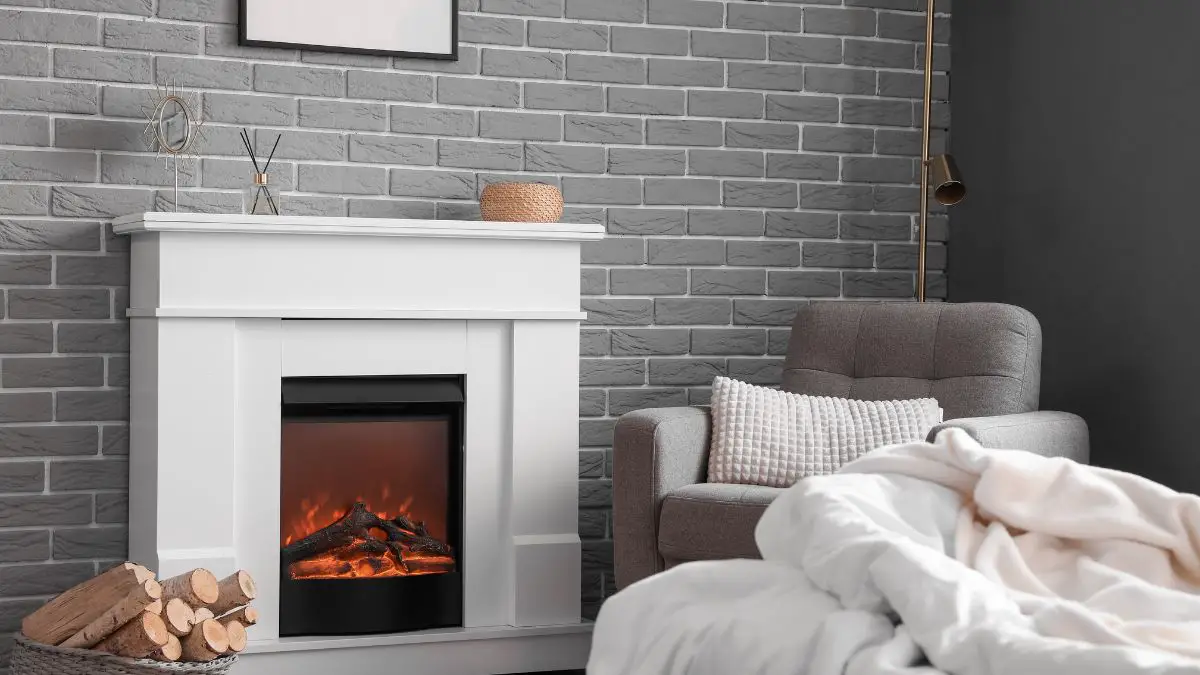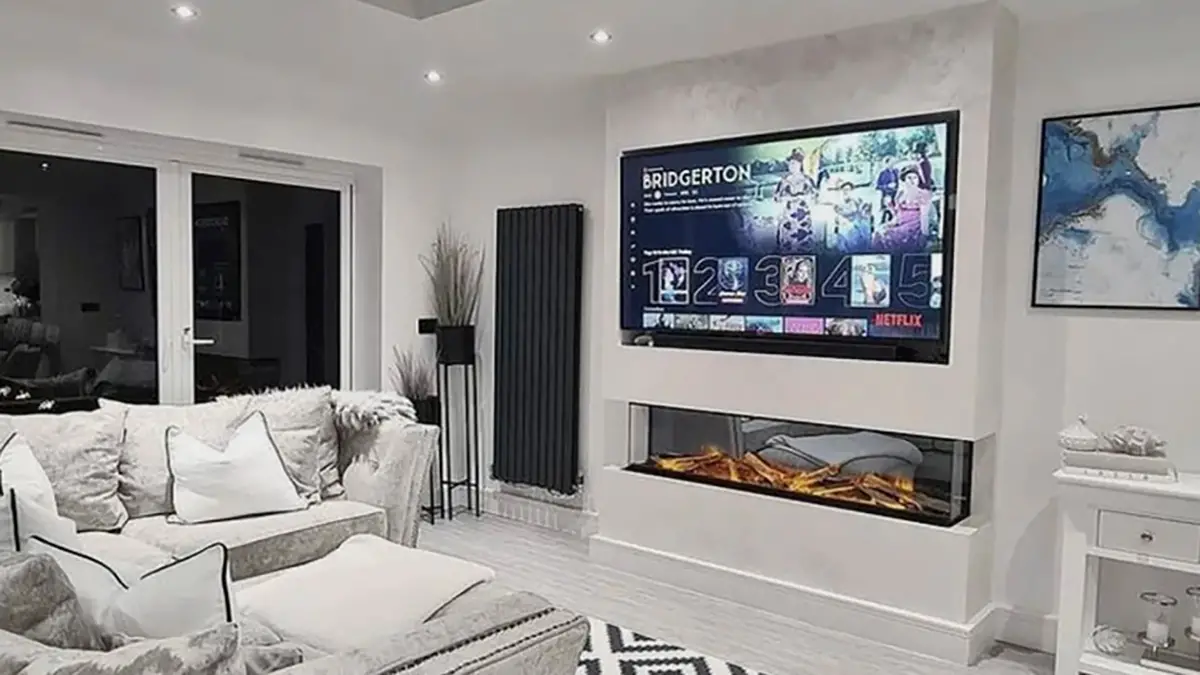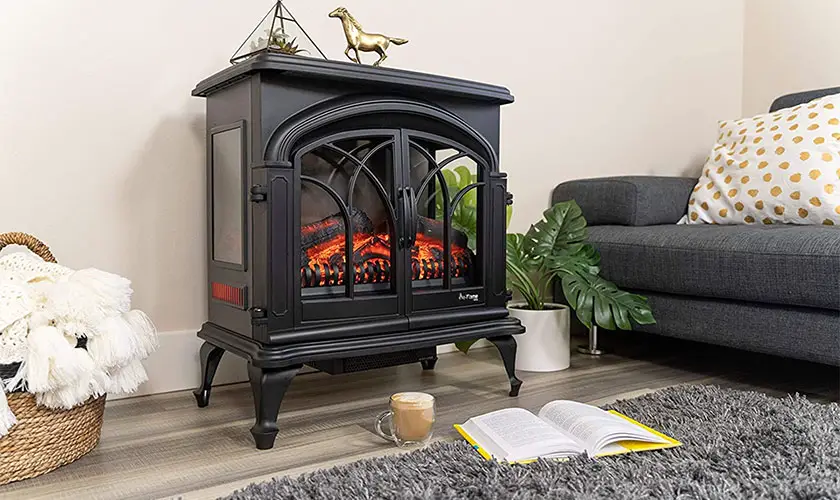It is essential to understand what the electric fireplace pros and cons are when deciding if they are right for you. Whether constructing a new living room or replacing your existing fireplace, electric-powered options provide numerous benefits that make them attractive. From their warm and inviting glow to their versatility, there are plenty of reasons why people choose these modern-day marvels!
When considering electric fireplace pros and cons, some people also wonder are electric fireplaces tacky. When professionally installed, electric fireplaces are beautiful and offer many perks. The best electric fireplace will depend on what design you are after,
Electric Fireplace Pros and Cons
There are pros and cons of electric fireplaces, including their simplicity of installation, costs, ambiance, and energy efficiency. Nevertheless, electric fireplaces may have drawbacks depending on your budget and lifestyle preferences.
Advantages of Electric Fireplaces
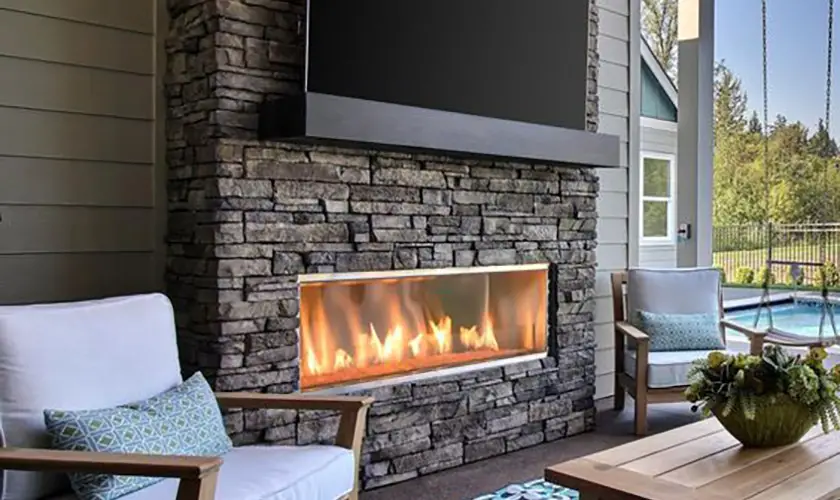
1. They Offer Easy Installation Options
One of the biggest advantages electric fireplaces have over traditional wood-burning models is their easy installation. Since electric fireplaces don’t require a chimney, flue, or venting system, they can be placed almost anywhere in your home without extensive construction or remodeling.
With most models, all that’s required is an electrical outlet and some wall space – no masonry work is necessary! The easiest models to install are freestanding electric fireplaces and TV stands that sit on the floor and plug into a wall outlet.
Wall mount models require a little more work. You’ll need to install a mounting bracket to the wall studs to hang the electric fireplace onto the wall securely.
Electric fireplaces are also lightweight and portable, so you can move them around quickly. Plus, they come with all the accessories you need for assembly, so there’s no need to purchase additional tools or materials.
2. They Are Easy to Maintain
Electric fireplaces also require very little maintenance. Unlike wood-burning models, electric fireplaces don’t need to be regularly cleaned or serviced. The lack of smoke and ash means electric fireplaces are virtually mess-free, preventing the need for regular cleaning.
Electric fireplaces don’t consume combustible fuels like wood, meaning there’s no need to purchase, store or replenish fuel supplies. This makes electric fireplaces a desirable option for those who don’t want to worry about the hassle of managing a wood-burning fireplace.
For most electric fireplaces, you wipe clean with a damp cloth. Electric fireplace inserts have more crevices, so a duster or small vacuum works better.
3. They are Cheaper to Operate and More Energy Efficient
Electric fireplaces are incredibly efficient, converting 100% of their energy into heat. Gas fireplaces, while still effective at warming a room, can only convert 70-90% of their energy into usable heat.
However, due to electricity’s often higher overall cost per hour compared to gas usage rates for heating units, electric devices may run for more hours than necessary to generate an equivalent amount of warmth.
According to the US Bureau of Labor and Statistics, the Dec 2022 National average for electricity is about $0.165 per kWh, while piped natural gas runs about $1.667 per therm.
On average, electric fireplace owners can save up to 40% on their heating costs each year compared to other heating options. Additionally, electric fireplaces are an eco-friendly option as they produce fewer pollutants than traditional models.
Electric fireplaces are not ideal as a primary heat source, but if you have gas or propane heat, installing an electric fireplace can provide supplemental heat, allowing you to run your furnace less.
4. They are Ideal for Spaces without Chimneys
One of the significant advantages electric fireplaces have over traditional wood-burning models is that they don’t require a chimney, flue, or venting system. This makes electric fireplaces an excellent option for those who live in small homes, apartments, or anywhere that doesn’t offer a chimney or other forms of ventilation.
Most freestanding electric fireplaces are also lightweight and portable so that they can be moved around easily. Plus, they come with all the accessories you need for assembly, so there’s no need to purchase additional tools or materials.
Some larger electric fireplace mantels are better as stationary pieces of furniture. However, you can move them if need be. Because chimneys or metal flues are fixed, you can’t move those sources like an electric fireplace.
5. Electric Fireplaces are Safe to Use
Electric fireplaces are safe and efficient alternatives to wood-burning models, offering all the warmth and ambiance of a real fireplace without any risks. Unlike traditional models, electric fireplaces don’t emit smoke or harmful pollutants in your home, making them an ideal choice for those who suffer from asthma or allergies.
Electric fireplaces don’t use an open flame, so there is no risk of accidental fires due to carelessness or negligence. Furthermore, electric fireplaces have various safety features, such as advanced heat sensors that automatically turn off the unit if it gets too hot.
Electric fireplaces generally stay cool to the touch, meaning they are safe around children and pets. The one exception is the heater vent, which can get hot if left on for a long time.
With electric fireplaces, you can enjoy all the benefits of having a cozy fireplace without any of the risks associated with traditional models!
6. Electric Fireplaces Are Quiet
If you’re wondering are electric fireplaces noisy, fear not; they are very quiet, especially when the heater is off. Depending on your model, most heaters operate at 50 decibels or less on high.
The quietest electric fireplaces operate around 38 decibels on high. For comparison, 40 decibels is about equivalent to a microwave.
Drawbacks of Electric Fireplaces
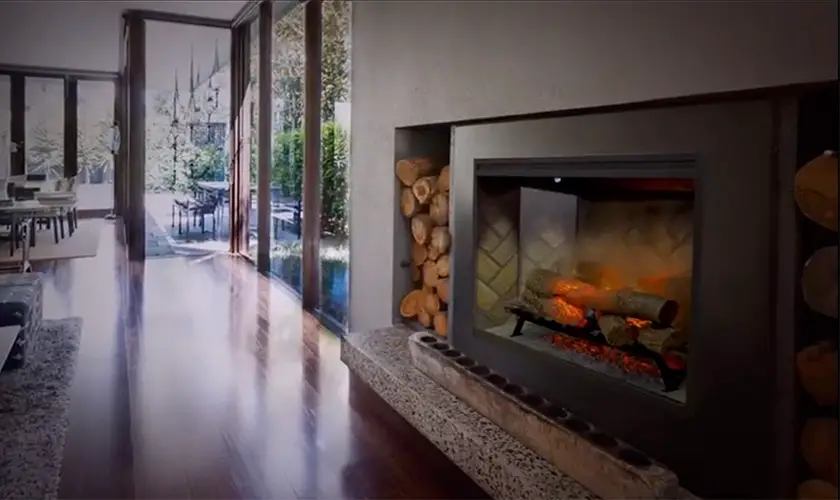
1. They have Limited Heat Output
Electric fireplaces can give off heat to warm a small area (about 400 square feet), making them unsuitable for larger spaces or rooms with higher ceilings. Some models say they can heat up to 1000 square feet but only as a supplemental heat source.
Electric fireplaces can’t be used as primary heating sources since they cannot produce enough consistent warmth to heat an entire home effectively. They can produce about 5118 BTUs of maximum heat output. Electric fireplaces offer two heat settings of 750 watts (Low) and 1500 watts (High).
Select luxury models offer a digital thermostat set between 68 and 88 degrees Fahrenheit, allowing it to adjust the heat output according to the room temperature.
Furthermore, electric fireplaces lack the power and capacity that wood-burning models possess, making them less efficient when providing supplemental heating during extremely cold temperatures. Despite these drawbacks, electric fireplaces remain a cost-effective option if you’re looking for supplemental heating in smaller areas.
2. Electric Fireplaces Lack the Ambiance of Traditional Fireplaces
Though electric fireplaces offer many advantages over traditional wood-burning models, such as convenience and cost-effectiveness, they may not provide the same ambiance. Models have come a long way in recent years and can closely mimic a real flame, but it remains obvious it’s a fake flame up close.
Electric fireplaces also lack the crackling of a real fire and the smell of burning wood, which is often associated with a cozy fireplace.
Furthermore, electric fireplaces don’t produce any smoke r ash like their wood-burning counterparts, so you won’t get the same smoky aroma in your home that many associates with fond childhood memories with family and friends.
Electric fireplaces may be unable to replicate all the elements of a traditional fireplace that make it so special and unique. However, these electric units are a homerun for those looking for a modern and eco-friendly twist on the fireplace.
3. Limited Flame and Ember Options
Though electric fireplaces offer many advantages over traditional wood-burning models, there are some drawbacks regarding the flame and ember options available with electric fireplaces.
Since electric fireplaces don’t produce a real flame or embers like their wood-burning counterparts, they do and, therefore, can be limited in terms of providing an authentic fireplace experience.
Electric fireplaces use a variety of media bed options like crystals or faux logs and an array of color combinations and flame speeds.
Furthermore, most electric fireplaces may lack the crackling sound associated with burning logs, making them seem less realistic. Additionally, some lesser electric fireplace models come with only one type of flame effect as well as limited color and intensity settings, so they may not be able to provide the same variety that you get from a real wood-burning fireplace.
Those looking for the most realistic electric fireplaces may not be able to provide all the elements necessary to replicate this feeling without spending a lot of money.
4. Recessed Models May Require a Dedicated Circuit
One potential drawback of recessed electric fireplace installations is that they may require a dedicated circuit. You’ll need an electrician to install new wiring for your fireplace to work correctly.
Most electric fireplaces operate off 11 watts of power and need a 120-volt circuit on a 20 amp breaker. A 15 amp breaker may work but could frequently trip you to run the heater and other household appliances together. VHugeelectric fireplaces with more heating output require a 240-volt circuit and a 30-amp or higher breaker.
This could be an extra expense and hassle if you don’t have an existing outlet close enough or powerful enough for your electric fireplace.
5. Some Models have Higher Upfront Costs than Wood or Gas Fireplaces
Not all electric fireplaces are easy to install. Some require professional installation or at least a high DIY skillset.
Many luxury electric fireplaces are typically more expensive than traditional wood-burning or gas models due to the cost associated with purchase and installation. Electric fireplaces require electric power, and installing circuits for electric fireplaces can significantly add to the overall price.
The average cost of an electric fireplace can cost from $300 to $5,000 for just the fireplace. That doesn’t include the installation. Most linear fireplaces that flush mount into the wall cost about $350 to $2,000. Some freestanding electric fireplace mantels can cost $1,500 to $5,000.
Depending on your design, installing an electric fireplace can cost from $1,000 to $5,000 for building materials, wire, and labor. You’ll need to be sure to follow local electric fireplace code requirements. The more elaborate the concept, the higher the cost will be.
Conclusion
In conclusion, electric fireplaces offer many benefits compared to traditional wood-burning models, such as using electric power, providing supplemental heat, not producing any smoke or ash, and having a clean, modern aesthetic.
However, electric fireplaces also have drawbacks, requiring a dedicated circuit, limited flame and ember options, and higher upfront costs than traditional wood-burning models. When considering electric fireplace pros and cons, it’s important to consider your overall design.
Electric fireplaces are the optimal choice for anyone seeking to upgrade their home heating system. Forget tedious installation and high maintenance costs. Electric fireplaces offer an easy setup process with enviable energy efficiency levels and a safe operation that won’t break your bank account.
Plus, you can revel in a traditional fireplace’s ambiance without fuss! AlIt’simply impossible not to love them.




